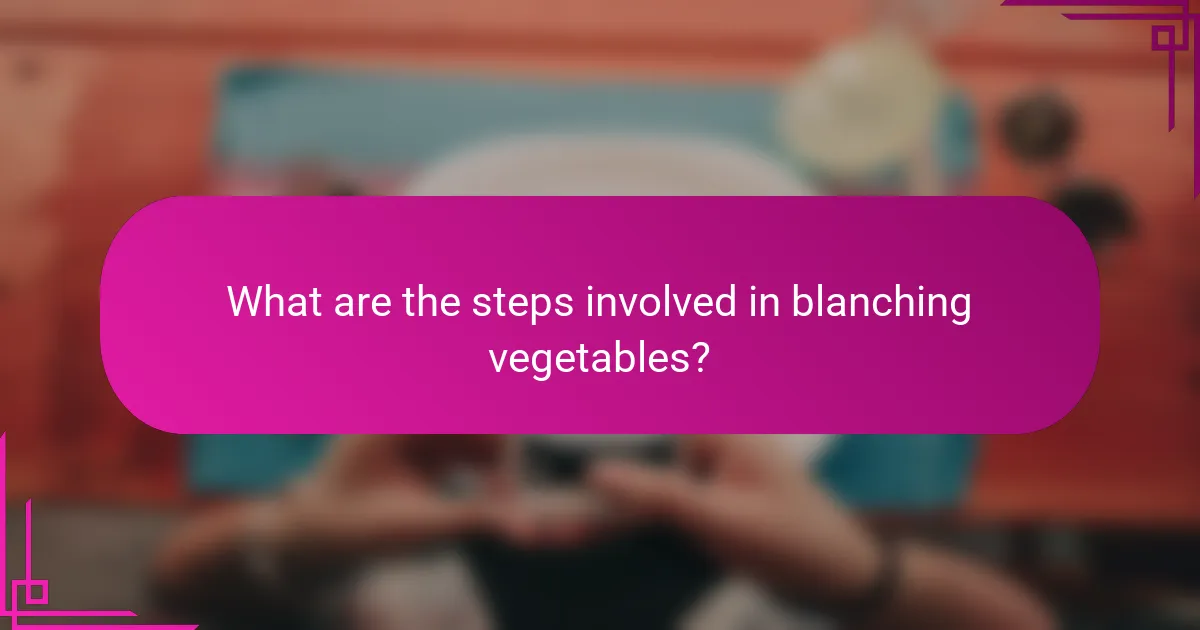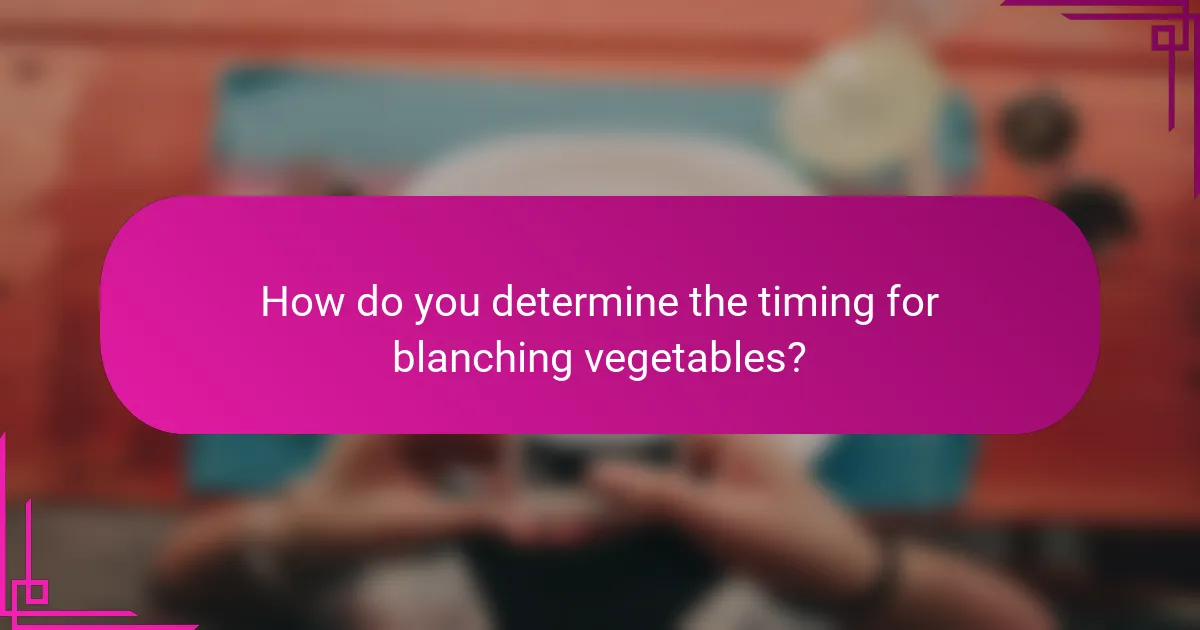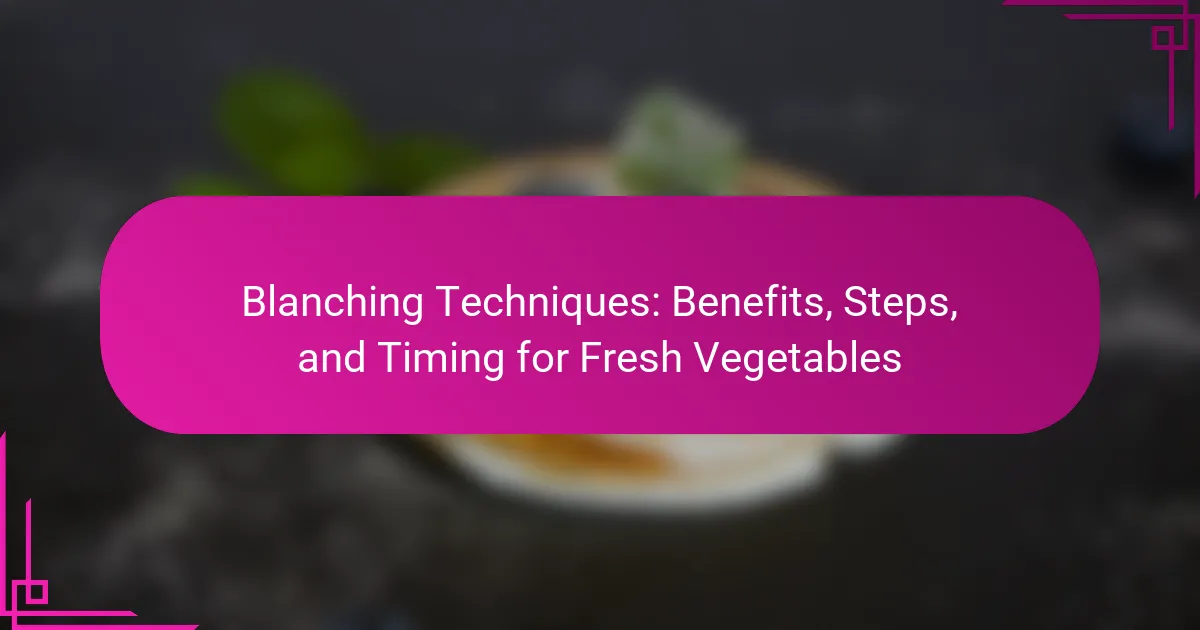Blanching techniques involve the brief cooking of vegetables in boiling water followed by rapid cooling in ice water, aimed at preserving color, flavor, and nutrients. This method is particularly beneficial before freezing vegetables, as it enhances texture and reduces future cooking time. The article outlines the essential steps for blanching, including preparation, boiling, and cooling, while emphasizing the importance of timing specific to each vegetable type to achieve optimal results. Additionally, it highlights the necessity of preparing an ice bath to prevent overcooking and provides USDA-recommended blanching times to ensure effective preservation of quality.

What are Blanching Techniques?
Blanching techniques involve briefly cooking vegetables in boiling water, then rapidly cooling them in ice water. This process preserves color, flavor, and nutrients. Blanching also helps in removing the skins from certain vegetables. The technique is commonly used before freezing vegetables to maintain quality. It is essential for enhancing the texture and reducing cooking time later. The process typically lasts from 30 seconds to a few minutes, depending on the vegetable. Research shows that blanching can reduce enzyme activity that causes loss of flavor and color during storage.
How does blanching affect fresh vegetables?
Blanching affects fresh vegetables by briefly cooking them in boiling water. This process helps preserve color, texture, and nutritional value. Blanching also deactivates enzymes that can cause loss of flavor and color during storage. For example, vegetables like broccoli and green beans maintain vibrant colors when blanched. Additionally, blanching can enhance the vegetables’ crispness. A study published in the Journal of Food Science found that blanching can reduce the microbial load on vegetables. This makes them safer for consumption. Overall, blanching is an effective technique for preparing fresh vegetables for freezing or cooking.
What chemical changes occur during the blanching process?
During the blanching process, several chemical changes occur in vegetables. Enzymatic activity is deactivated, which helps preserve color and flavor. The cell walls soften due to the breakdown of pectin. Nutrient retention is enhanced as some water-soluble vitamins are preserved. Additionally, the Maillard reaction begins, contributing to flavor development. The blanching process also reduces microbial load, enhancing food safety. These changes collectively improve the quality and shelf life of vegetables.
How does blanching impact the texture and flavor of vegetables?
Blanching significantly impacts the texture and flavor of vegetables. This cooking technique involves briefly boiling vegetables and then rapidly cooling them in ice water. The process softens the cell walls, resulting in a more tender texture. Blanching also helps to preserve the vibrant color of vegetables, making them visually appealing.
Additionally, it reduces bitterness in some vegetables, enhancing their overall flavor. For example, blanching broccoli can make it sweeter and less fibrous. Studies show that blanching can also help retain nutrients by reducing enzyme activity that leads to nutrient loss. Overall, blanching is an effective method for improving both the texture and flavor of various vegetables.
What are the benefits of blanching fresh vegetables?
Blanching fresh vegetables offers several benefits. It preserves color, texture, and flavor by stopping enzymatic reactions that can lead to spoilage. Blanching also enhances the nutritional value by making vitamins and minerals more bioavailable. Additionally, it reduces microbial load, making vegetables safer to consume. This technique can also improve the overall appearance of the vegetables, making them more appealing. For example, blanched green beans retain their vibrant green color compared to unblanched ones. Furthermore, blanching makes peeling easier for certain vegetables, like tomatoes and peaches. Overall, blanching is a beneficial step in vegetable preparation that enhances quality and safety.
How does blanching help preserve nutrients in vegetables?
Blanching helps preserve nutrients in vegetables by briefly cooking them in boiling water. This process inactivates enzymes that can cause nutrient loss. It also helps retain color, texture, and flavor. Studies show that blanching can reduce the loss of vitamins, particularly vitamin C and some B vitamins. For example, blanching broccoli can retain up to 90% of its vitamin C content. The quick heating followed by rapid cooling also minimizes nutrient degradation during storage. Thus, blanching is an effective technique for maintaining the nutritional quality of vegetables.
What role does blanching play in food safety?
Blanching plays a crucial role in food safety by inactivating enzymes that can cause spoilage. This process involves briefly boiling vegetables and then rapidly cooling them in ice water. By doing so, blanching helps preserve color, texture, and nutritional value. Additionally, blanching reduces microbial load on the surface of vegetables. Studies show that this technique can lower the risk of foodborne illnesses. For instance, it can eliminate pathogens like Salmonella and E. coli effectively. Thus, blanching is an essential step in preparing fresh vegetables for safe consumption.
How does blanching enhance the color of vegetables?
Blanching enhances the color of vegetables by briefly cooking them in boiling water. This process deactivates enzymes that can cause color degradation. It also helps to set the vibrant colors of vegetables, such as greens and reds. The heat from blanching brightens the pigments in vegetables. For example, chlorophyll in green vegetables becomes more vivid. Additionally, blanching can remove air from the plant cells. This results in a more appealing appearance. Studies show that properly blanched vegetables retain their color longer during storage.

What are the steps involved in blanching vegetables?
The steps involved in blanching vegetables include preparing the vegetables, boiling water, blanching, and cooling. First, wash and cut the vegetables to the desired size. Next, bring a large pot of water to a rolling boil. Add the vegetables to the boiling water and cook for a specific time, usually 1 to 5 minutes, depending on the type of vegetable. After blanching, immediately transfer the vegetables to an ice water bath to stop the cooking process. Drain the vegetables after they are cooled. Finally, dry the vegetables before storing or freezing them.
What materials are needed for blanching?
The materials needed for blanching include a large pot of boiling water and a bowl of ice water. A slotted spoon or strainer is also essential for transferring vegetables. Additionally, fresh vegetables to be blanched are required. The boiling water typically needs to be at a rolling boil, around 212°F (100°C). Ice water is used to stop the cooking process immediately. Using a slotted spoon helps in removing the vegetables from the hot water efficiently. These materials ensure effective blanching, preserving color and texture.
What types of pots or containers are best for blanching?
Large stockpots or blanching pots are best for blanching. These pots provide ample space for boiling water and vegetables. They typically have a capacity of at least 4 to 8 quarts. Stainless steel is a preferred material due to its durability and heat conductivity. Additionally, pots with a wide opening allow for easy access when adding or removing vegetables. A colander or steamer basket is also useful for draining vegetables after blanching. This setup ensures efficient cooking and prevents overcooking.
How do you select the right vegetables for blanching?
Select vegetables that are fresh and firm for blanching. Freshness ensures optimal flavor and texture. Firm vegetables retain their structure during the blanching process. Choose vegetables that are in season for the best taste. Common choices include green beans, broccoli, and carrots. Avoid overripe or wilted vegetables as they may become mushy. Cut vegetables into uniform sizes for even blanching. This promotes consistent cooking and texture. Lastly, select vibrant-colored vegetables for visual appeal and nutrient retention.
What is the blanching process?
The blanching process involves briefly boiling vegetables and then rapidly cooling them in ice water. This technique preserves color, texture, and nutritional value. Blanching also helps to remove surface dirt and kill bacteria. It is commonly used before freezing vegetables. The boiling time varies depending on the vegetable type. For example, green beans require about three minutes, while carrots need around five minutes. The immediate cooling halts the cooking process. This method is essential for preparing vegetables for long-term storage.
How do you prepare vegetables for blanching?
To prepare vegetables for blanching, first wash them thoroughly under running water. This removes dirt and pesticides. Next, trim or cut the vegetables into uniform sizes. Uniform pieces ensure even blanching. Bring a large pot of water to a rolling boil. The boiling water should be sufficient to submerge the vegetables completely. Prepare an ice bath by filling a bowl with ice and cold water. This will stop the cooking process after blanching. Once the water is boiling, add the vegetables and cook for the recommended time based on the type of vegetable. After blanching, quickly transfer the vegetables to the ice bath to cool. This method preserves color, texture, and nutrients.
What are the specific steps to blanch vegetables properly?
To blanch vegetables properly, follow these specific steps. First, prepare a large pot of boiling water. The water should be at a rolling boil before adding the vegetables. Next, wash and cut the vegetables into uniform pieces. This ensures even cooking. Once the water is boiling, add the vegetables in small batches. Blanch them for the appropriate time, usually 1 to 5 minutes, depending on the type of vegetable. After blanching, immediately transfer the vegetables to a bowl of ice water. This stops the cooking process and preserves color and texture. Allow the vegetables to cool completely in the ice water. Finally, drain the vegetables and pat them dry before storing or using them.

How do you determine the timing for blanching vegetables?
Timing for blanching vegetables depends on the type of vegetable and its size. Each vegetable has a specific blanching time to preserve color, flavor, and nutrients. For example, green beans typically require 3 minutes, while broccoli may need 2 to 3 minutes. Smaller pieces of vegetables blanch faster than larger ones.
It is essential to prepare an ice bath before blanching. This halts the cooking process immediately after blanching. Overcooking can lead to loss of texture and nutrients. A timer should be used to ensure accuracy during the blanching process.
Referencing the USDA guidelines, the recommended blanching times for common vegetables are well-documented. Following these guidelines ensures optimal results when blanching.
What factors influence blanching time?
Blanching time is influenced by several key factors. These include the type of vegetable being blanched, as different vegetables have varying densities and structures. The size and cut of the vegetable pieces also play a significant role; smaller pieces typically require less time to blanch. Additionally, the temperature of the water used for blanching affects the duration; hotter water reduces blanching time. The altitude at which blanching occurs can influence boiling point, thus altering blanching time. Lastly, the desired texture and flavor intensity after blanching can dictate how long the process should last.
How does the size and type of vegetable affect blanching duration?
The size and type of vegetable significantly influence blanching duration. Larger vegetables require longer blanching times to ensure even cooking. For instance, whole carrots need about 5 to 7 minutes, while diced carrots only take 2 to 3 minutes. Different types of vegetables also have varying blanching needs. Leafy greens, like spinach, blanch quickly, typically in just 2 minutes. In contrast, denser vegetables, such as broccoli, may need 3 to 5 minutes for optimal results. The water temperature during blanching can also impact duration. Generally, water should be at a rolling boil for effective blanching.
What tools can help you time the blanching process accurately?
A kitchen timer is a primary tool that can help you time the blanching process accurately. It allows you to set specific durations for each vegetable being blanched. A digital timer can provide precise measurements down to seconds. Stopwatch apps on smartphones are also effective for timing blanching. Additionally, some cooking thermometers come with timers built in. These tools ensure that vegetables are blanched for the optimal time to preserve color and texture. Accurate timing is crucial since over-blanching can lead to loss of nutrients and flavor.
What are common mistakes to avoid when blanching?
Common mistakes to avoid when blanching include not using enough water. Insufficient water can lead to uneven cooking. Another mistake is failing to prepare an ice bath. An ice bath stops the cooking process, preserving texture and color. Overcooking vegetables is also a frequent error. This can result in loss of nutrients and flavor. Additionally, not blanching for the correct duration can affect quality. Each vegetable has a specific blanching time for optimal results. Lastly, skipping the drying step after blanching can lead to excess moisture. This moisture can affect storage and further cooking methods.
How can over-blanching affect vegetable quality?
Over-blanching can lead to a decline in vegetable quality. It causes loss of flavor, color, and nutrients. Vegetables may become mushy and lose their crisp texture. Over-blanching can also result in a dull appearance. Nutrient loss occurs due to prolonged exposure to heat and water. For example, vitamins such as vitamin C and B vitamins are particularly sensitive to heat. Studies show that over-blanching can reduce these nutrients by up to 50%. Additionally, it may promote enzymatic activity, leading to spoilage. Proper timing is essential to maintain optimal vegetable quality.
What signs indicate that vegetables have been properly blanched?
Properly blanched vegetables exhibit bright, vibrant colors. This color change indicates that the enzymes responsible for degradation have been inactivated. Additionally, the vegetables should be tender yet crisp, maintaining their texture. A further sign is the presence of a slight sheen on the surface, indicating moisture retention. The blanching process also leads to a reduction in strong odors, making the vegetables smell fresher. Finally, a quick cooling in ice water after blanching helps to lock in these qualities, preventing overcooking.
What are best practices for blanching fresh vegetables?
The best practices for blanching fresh vegetables include selecting high-quality vegetables, preparing an ice bath, and timing the blanching process accurately. Use fresh, firm vegetables for optimal results. Start by washing them thoroughly to remove dirt and pesticides. Prepare a large pot of boiling water. Add salt to the water to enhance flavor and color retention. Blanch the vegetables in batches to avoid overcrowding. Each type of vegetable requires specific blanching times; for example, green beans take about 3 minutes, while broccoli takes about 2 minutes. Immediately transfer the blanched vegetables to the prepared ice bath. This stops the cooking process and preserves the vibrant color and texture. Drain the vegetables well before storing or freezing. Following these steps ensures that the vegetables maintain their nutritional value and taste.
How can you ensure optimal results when blanching?
To ensure optimal results when blanching, maintain the right water temperature. Water should be at a rolling boil before adding vegetables. This preserves color, texture, and nutrients. Use enough water to prevent temperature drops. Blanch for the recommended time based on vegetable type. Over-blanching can lead to loss of flavor and nutrients. Immediately transfer vegetables to ice water after blanching. This stops the cooking process and maintains crispness. Drain thoroughly before further preparation. Following these steps maximizes the benefits of blanching.
What tips should you follow for storing blanched vegetables?
Store blanched vegetables in airtight containers or freezer bags. This prevents moisture loss and freezer burn. Label containers with the date to track freshness. Blanched vegetables should be stored in the freezer for optimal preservation. Use them within 8 to 12 months for best quality. Ensure vegetables are completely cooled before storage. This helps maintain texture and flavor. Avoid packing them too tightly to allow for proper air circulation.
Blanching techniques involve briefly cooking fresh vegetables in boiling water followed by rapid cooling in ice water, preserving their color, flavor, and nutritional value. This article outlines the benefits of blanching, including enhanced texture, reduced cooking time, and improved food safety by reducing microbial load. It details the specific steps involved in the blanching process, the necessary materials, and factors influencing timing, emphasizing the importance of proper technique to avoid common mistakes. Additionally, the article highlights best practices for storing blanched vegetables to maintain their quality over time.
